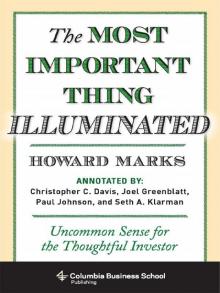- Home
- Howard Marks
The Most Important Thing Illuminated Page 3
The Most Important Thing Illuminated Read online
Page 3
Okay then, what about the celebrated investors we hear so much about? First, one or two good years prove nothing; chance alone can produce just about any result. Second, statisticians insist nothing can be proved with statistical significance until you have enough years of data; I remember a figure of sixty-four years, and almost no one manages money that long. Finally, the emergence of one or two great investors doesn’t disprove the theory. The fact that the Warren Buffetts of this world attract as much attention as they do is an indication that consistent outperformers are exceptional.
One of the greatest ramifications of the Chicago theory has been the development of passive investment vehicles known as index funds. If most active portfolio managers making “active bets” on which securities to overweight and underweight can’t beat the market, why pay the price—in the form of transaction costs and management fees—entailed in trying? With that question in mind, investors have put growing amounts in funds that simply invest a market-determined amount in each stock or bond in a market index. In this way, investors enjoy market returns at a fee of just a few hundredths of a percent per year.
Everything moves in cycles, as I’ll discuss later, and that includes “accepted wisdom.” So the efficient market hypothesis got off to a fast start in the 1960s and developed a lot of adherents. Objections have been raised since then, and the general view of its applicability rises and falls.
I have my own reservations about the theory, and the biggest one has to do with the way it links return and risk.
According to investment theory, people are risk-averse by nature, meaning that in general they’d rather bear less risk than more. For them to make riskier investments, they have to be induced through the promise of higher returns. Thus, markets will adjust the prices of investments so that, based on the known facts and common perceptions, the riskier ones will appear to promise higher returns.
Because theory says in an efficient market there’s no such thing as investing skill (commonly referred to today as alpha) that would enable someone to beat the market, all the difference in return between one investment and another—or between one person’s portfolio and another’s—is attributable to differences in risk. In fact, if you show an adherent of the efficient market hypothesis an investment record that appears to be superior, as I have, the answer is likely to be, “The higher return is explained by hidden risk.” (The fallback position is to say, “You don’t have enough years of data.”)
Once in a while we experience periods when everything goes well and riskier investments deliver the higher returns they seem to promise. Those halcyon periods lull people into believing that to get higher returns, all they have to do is make riskier investments. But they ignore something that is easily forgotten in good times: this can’t be true, because if riskier investments could be counted on to produce higher returns, they wouldn’t be riskier.
Every once in a while, then, people learn an essential lesson. They realize that nothing—and certainly not the indiscriminate acceptance of risk—carries the promise of a free lunch, and they’re reminded of the limitations of investment theory.
That’s the theory and its implications. The key question is whether it’s right: Is the market unbeatable? Are the people who try wasting their time? Are the clients who pay fees to investment managers wasting their money? As with most other things in my world, the answers aren’t simple … and they’re certainly not yes or no.
I don’t believe the notion of market efficiency deserves to be dismissed out of hand. In principle, it’s fair to conclude that if thousands of rational and numerate people gather information about an asset and evaluate it diligently and objectively, the asset’s price shouldn’t stray far from its intrinsic value. Mispricings shouldn’t be regularly extant, meaning it should be hard to beat the market.
In fact, some asset classes are quite efficient. In most of these:
• the asset class is widely known and has a broad following;
• the class is socially acceptable, not controversial or taboo;
• the merits of the class are clear and comprehensible, at least on the surface; and
• information about the class and its components is distributed widely and evenly.
SETH KLARMAN: Most of these characteristics are not permanent. Something broadly accepted can become controversial or even taboo. Information can become more or less available. Thus, an asset class deemed close to efficient at one point may become quite inefficient at another. European sovereign debt is a current example of this.
If these conditions are met, there’s no reason why the asset class should systematically be overlooked, misunderstood or underrated.
PAUL JOHNSON: Inverting these conditions yields a test of market inefficiency. For instance, in the first case, if an asset is not widely known and broadly followed, it might be inefficiently priced; in the second case, if an asset is controversial, taboo, or socially unacceptable, it might be inefficiently priced; and so on for each of the other two cases.
Take foreign exchange, for example. What are the things that determine the movements of one currency versus another? Future growth rates and inflation rates. Is it possible for any one person to systematically know much more about these things than everyone else? Probably not. And if not, then no one should be able to regularly achieve above-average risk-adjusted returns through currency trading.
What about the major stock markets, such as the New York Stock Exchange? Here millions of people are prospecting, driven by the desire for profit. They’re all similarly informed; in fact, it’s one of the goals of our market regulation that everyone should gain access to the same company information at the same time. With millions of people doing similar analysis on the basis of similar information, how often will stocks become mispriced, and how regularly can any one person detect those mispricings?
Answer: Not often, and not dependably. But that is the essence of second-level thinking.
Second-level thinkers know that, to achieve superior results, they have to have an edge in either information or analysis, or both. They are on the alert for instances of misperception. My son Andrew is a budding investor, and he comes up with lots of appealing investment ideas based on today’s facts and the outlook for tomorrow. But he’s been well trained. His first test is always the same: “And who doesn’t know that?”
In the vocabulary of the theory, second-level thinkers depend on inefficiency. The term inefficiency came into widespread use over the last forty years as the counterpoint to the belief that investors can’t beat the market. To me, describing a market as inefficient is a high-flown way of saying the market is prone to mistakes that can be taken advantage of.
Where might errors come from? Let’s consider the assumptions that underlie the theory of efficient markets:
• There are many investors hard at work.
• They are intelligent, diligent, objective, motivated and well equipped.
• They all have access to the available information, and their access is roughly equal.
• They’re all open to buying, selling or shorting (i.e., betting against) every asset.
For those reasons, theory says that all the available information will be smoothly and efficiently synthesized into prices and acted on whenever price/value discrepancies arise, so as to drive out those discrepancies.
But it’s impossible to argue that market prices are always right. In fact, if you look at the four assumptions just listed, one stands out as particularly tenuous: objectivity. Human beings are not clinical computing machines. Rather, most people are driven by greed, fear, envy and other emotions that render objectivity impossible and open the door for significant mistakes.
Likewise, what about the fourth assumption? Whereas investors are supposed to be open to any asset—and to both owning it and being short—the truth is very different. Most professionals are assigned to particular market niches, as in “I work in the equity department” or “I’m a bond manager.”<
br />
SETH KLARMAN: Silos are a double-edged sword. A narrow focus leads to potentially superior knowledge. But concentration of effort within rigid boundaries leaves a strong possibility of mispricings outside those borders. Also, if others’ silos are similar to your own, competitive forces will likely drive down returns in spite of superior knowledge within such silos.
And the percentage of investors who ever sell short is truly tiny. Who, then, makes and implements the decisions that would drive out relative mispricings between asset classes?
A market characterized by mistakes and mispricings can be beaten by people with rare insight. Thus, the existence of inefficiencies gives rise to the possibility of outperformance and is a necessary condition for it. It does not, however, guarantee it.
To me, an inefficient market is one that is marked by at least one (and probably, as a result, by all) of the following characteristics:
• Market prices are often wrong. Because access to information and the analysis thereof are highly imperfect, market prices are often far above or far below intrinsic values.
• The risk-adjusted return on one asset class can be far out of line with those of other asset classes. Because assets are often valued at other-than-fair prices, an asset class can deliver a risk-adjusted return that is significantly too high (a free lunch) or too low relative to other asset classes.
• Some investors can consistently outperform others. Because of the existence of (a) significant misvaluations and (b) differences among participants in terms of skill, insight and information access, it is possible for misvaluations to be identified and profited from with regularity.
This last point is very important in terms of what it does and does not mean. Inefficient markets do not necessarily give their participants generous returns. Rather, it’s my view that they provide the raw material—mispricings—that can allow some people to win and others to lose on the basis of differential skill. If prices can be very wrong, that means it’s possible to find bargains or overpay. For every person who gets a good buy in an inefficient market, someone else sells too cheap. One of the great sayings about poker is that “in every game there’s a fish. If you’ve played for 45 minutes and haven’t figured out who the fish is, then it’s you.” The same is certainly true of inefficient market investing.
“WHAT’S IT ALL ABOUT, ALPHA?” JULY 11, 2001
In the great debate over efficiency versus inefficiency, I have concluded that no market is completely one or the other. It’s just a matter of degree. I wholeheartedly appreciate the opportunities that inefficiency can provide, but I also respect the concept of market efficiency, and I believe strongly that mainstream securities markets can be so efficient that it’s largely a waste of time to work at finding winners there.
PAUL JOHNSON: This idea is extremely important because business schools tend to push the debate to one extreme or the other. Many of the academics want to argue for full market efficiency, which forces the practitioners to argue the opposite just to keep a balanced discussion. Marks offers a significantly superior way to manage the topic. A corollary that follows from Marks’s observation is that investors should look for markets or assets that are not fully efficiently priced rather than chase after the false god of completely inefficient markets.
In the end, I’ve come to an interesting resolution: Efficiency is not so universal that we should give up on superior performance. At the same time, efficiency is what lawyers call a “rebuttable presumption”—something that should be presumed to be true until someone proves otherwise. Therefore, we should assume that efficiency will impede our achievement unless we have good reason to believe it won’t in the present case.
Respect for efficiency says that before we embark on a course of action, we should ask some questions: have mistakes and mispricings been driven out through investors’ concerted efforts, or do they still exist, and why?
Think of it this way:
• Why should a bargain exist despite the presence of thousands of investors who stand ready and willing to bid up the price of anything that’s too cheap?
• If the return appears so generous in proportion to the risk, might you be overlooking some hidden risk?
• Why would the seller of the asset be willing to part with it at a price from which it will give you an excessive return?
• Do you really know more about the asset than the seller does?
• If it’s such a great proposition, why hasn’t someone else snapped it up?
Something else to keep in mind: just because efficiencies exist today doesn’t mean they’ll remain forever.
Bottom line: Inefficiency is a necessary condition for superior investing. Attempting to outperform in a perfectly efficient market is like flipping a fair coin: the best you can hope for is fifty-fifty. For investors to get an edge, there have to be inefficiencies in the underlying process—imperfections, mispricings—to take advantage of.
But let’s say there are. That alone is not a sufficient condition for outperformance. All that means is that prices aren’t always fair and mistakes are occurring: some assets are priced too low and some too high. You still have to be more insightful than others in order to regularly buy more of the former than the latter. Many of the best bargains at any point in time are found among the things other investors can’t or won’t do.
JOEL GREENBLATT: This is very important and helps explain why most professionals have a hard time beating the market. Investments that are out of favor, that don’t look so attractive in the near term, are avoided by most professionals, who feel they need to add performance right now.
Let others believe markets can never be beat. Abstention on the part of those who won’t venture in creates opportunities for those who will.
Is investment theory, with its notion of market efficiency, the equivalent of a physical law that is universally true? Or is it an irrelevant ivory-tower notion to be disregarded? In the end, it’s a question of balance, and balance comes from applying informed common sense. The key turning point in my investment management career came when I concluded that because the notion of market efficiency has relevance, I should limit my efforts to relatively inefficient markets where hard work and skill would pay off best.
JOEL GREENBLATT: Of course, some markets are more inefficient because they are less closely followed in general, but portions of widely followed markets, like common stocks, can also be inefficient. Stocks with smaller capitalization or stocks of companies going through extraordinary events come to mind.
Theory informed that decision and prevented me from wasting my time in the mainstream markets, but it took an understanding of the limits of the theory to keep me from completely accepting the arguments against active management.
In short, I think theory should inform our decisions but not dominate them. If we entirely ignore theory, we can make big mistakes. We can fool ourselves into thinking it’s possible to know more than everyone else and to regularly beat heavily populated markets. We can buy securities for their returns but ignore their risk. We can buy fifty correlated securities and mistakenly think we’ve diversified. …
But swallowing theory whole can make us give up on finding bargains, turn the process over to a computer and miss out on the contribution skillful individuals can make. The image here is of the efficient-market-believing finance professor who takes a walk with a student.
“Isn’t that a $10 bill lying on the ground?” asks the student.
“No, it can’t be a $10 bill,” answers the professor. “If it were, someone would have picked it up by now.”
The professor walks away, and the student picks it up and has a beer.
“WHAT’S IT ALL ABOUT, ALPHA?” JULY 11, 2001
3
The Most Important Thing Is … Value
For investing to be reliably successful, an accurate estimate of intrinsic value is the indispensable starting point. Without it, any hope for consistent success as an investor is just that: hope.
>
JOEL GREENBLATT: Warren Buffett says that the best investment course would teach just two things well: How to value an investment and how to think about market price movements. Step one starts right here.
The oldest rule in investing is also the simplest: “Buy low; sell high.” Seems blindingly obvious: Who would want to do anything else? But what does that rule actually mean? Again, obvious—on the surface: it means that you should buy something at a low price and sell it at a high price. But what, in turn, does that mean? What’s high, and what’s low?
On a superficial level, you can take it to mean that the goal is to buy something for less than you sell it for. But since your sale will take place well down the road, that’s not much help in figuring out the proper price at which to buy today. There has to be some objective standard for “high” and “low,” and most usefully that standard is the asset’s intrinsic value. Now the meaning of the saying becomes clear: buy at a price below intrinsic value, and sell at a higher price. Of course, to do that, you’d better have a good idea what intrinsic value is. For me, an accurate estimate of value is the indispensable starting point.
PAUL JOHNSON: This is the first building block of value investing.
To simplify (or oversimplify), all approaches to investing in company securities can be divided into two basic types: those based on analysis of the company’s attributes, known as “fundamentals,” and those based on study of the price behavior of the securities themselves. In other words, an investor has two basic choices: gauge the security’s underlying intrinsic value and buy or sell when the price diverges from it, or base decisions purely on expectations regarding future price movements.

 Mr Nice
Mr Nice The Howard Marks Book of Dope Stories
The Howard Marks Book of Dope Stories Senor Nice: Straight Life From Wales to South America
Senor Nice: Straight Life From Wales to South America The Score
The Score Sympathy for the Devil
Sympathy for the Devil The Most Important Thing Illuminated
The Most Important Thing Illuminated Senor Nice
Senor Nice Howard Marks' Book of Dope Stories
Howard Marks' Book of Dope Stories